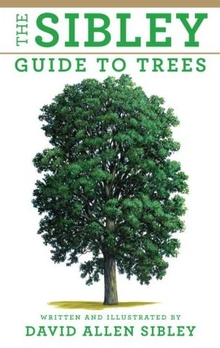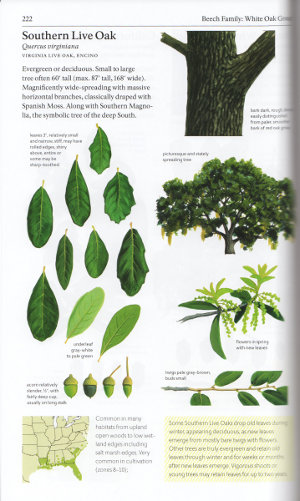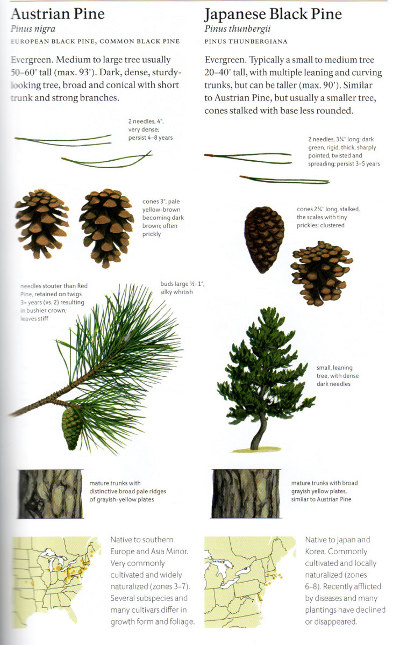Reviewed by Grant McCreary on March 25th, 2011.
Birder 1: Whoa! I’ve got a gorgeous male Cerulean Warbler.
Birder 2: Where?!?
Birder 1: In that hickory straight ahead, 2 o’clock.
Birder 2: Which one’s the hickory?
Birder 1: The one with the straight, compound leaves that…
Birder 2: Wait, straight what?
Birder 1: Compound leaves – it’s where…never mind, it just flew off.
Birder 2: *#$&@!
I normally write about bird books on this site. So why review a guide to trees? If the conversation above sounds familiar, you know that it is in a birder’s self-interest to be at least somewhat familiar with trees. Further, I think it is important to be not just a birder, but a well-rounded naturalist. Birds and trees go together, and I think it’s valuable to learn about both and how they are intertwined. Finally, I was interested in this book specifically due to its author. David Allen Sibley is the creator of a very highly regarded (and my favorite) field guide to North American birds.
The Sibley Guide to Trees covers 668 trees found in the continental United States and Canada. All native trees are included, except those found only in southern Florida, as are many commonly cultivated species.
For those familiar with Sibley’s bird guide, this one is very similar. The general layout is the same, with the accounts laid out vertically on the page. Most occupy half a page, though a few are smaller and a good number are full-page. And, of course, it is illustrated by Sibley’s gorgeous paintings.
Species Accounts
- Name – common, scientific, and other commonly used names (very helpful)
- Text – evergreen/deciduous; size; general characteristics
- Illustrations
- Range map
This book is copiously illustrated with Sibley’s fantastic paintings. We get not one, but multiple images of leaves, showing the possible variation. The underleaf is also shown, as well as the fall colors where appropriate. Additionally, any flowers and fruit are illustrated. For most, sample twigs are shown and for many a section of the trunk detailing the bark. Where the shape or structure as a whole is distinctive, the entire tree is portrayed.
The maps use a green color to show the range of native trees, while yellow indicates where non-native species have “escaped” and are growing in the wild. Accompanying the maps is some text giving the abundance, preferred habitat, and hardiness zones the tree is found in. For native trees, it mentions whether it is cultivated or not and for introduced species tells where it is natively found.
The accounts look sparse text-wise, but a deceptive amount of information is included. In addition to the text at the beginning of the account and that associated with the maps, some trees have highlighted boxes of text that discuss hybridization, identification, and other interesting information. The illustrations are also captioned with pertinent information, like the size of leaves and fruit.
Introduction
A 30-page introduction covers the basics of tree taxonomy, conservation, and identification. It provides a lot of useful information and shouldn’t be skipped. Each family is also introduced within the body of the book. Most are just a few paragraphs, maybe with a picture or two. On the other hand, the introduction for larger families – oaks, for example – can span several pages and feature many illustrations.
Approach
Many tree field guides organize species based on shared characteristics and include a key to help in identification. A key is basically a series of questions that will lead you to a (hopefully) correct identification, or at least greatly narrow down the possibilities. The Sibley Guide to Trees takes a different approach. First, it is organized taxonomically. So trees are grouped with those that are most closely related to it, which may or may not be the trees that look the most alike. And there is no key.
Instead, Sibley takes a more “holistic” approach. He encourages you to look at the whole tree. In order to best understand his approach, you should read Sibley’s description and rational of his choice. As a beginner in tree identification, I must admit that I still longed for some kind of key, something to make identification easier. But as I considered it further, I realized that, as a birder, I was already comfortable with this holistic approach.
In fact, in many respects The Sibley Guide to Trees was written for birders. In the post linked above, Sibley even wrote that he “tried to approach tree identification in the same way that modern birders approach bird identification, to create ‘a tree guide for birdwatchers’”. Obviously, you don’t have to be a birdwatcher to use this book. But if you are, you should already have a good grasp of what the author is trying to do.
Being the same size as the “big” Sibley bird guide, this book may be a bit large to carry on you. But it could be carried in a backpack or, of course, kept in the car.
As with any work of this magnitude, errors are bound to creep in. A list of errors and corrections can be found on Sibley’s website.
Recommendation
The Sibley Guide to Trees is a beautiful book that (I can’t believe I’m saying this about a tree book) is fun to simply flip through and browse. But it’s also informative and should prove very helpful in tree identification. I’d recommend it to anyone interested in the trees around them, and especially so to fellow birders.
Disclosure: I get a small commission for purchases made through links in this post.
Disclosure: The item reviewed here was a complementary review copy provided by the publisher. But the opinion expressed here is my own, it has not been influenced in any way.







Comment